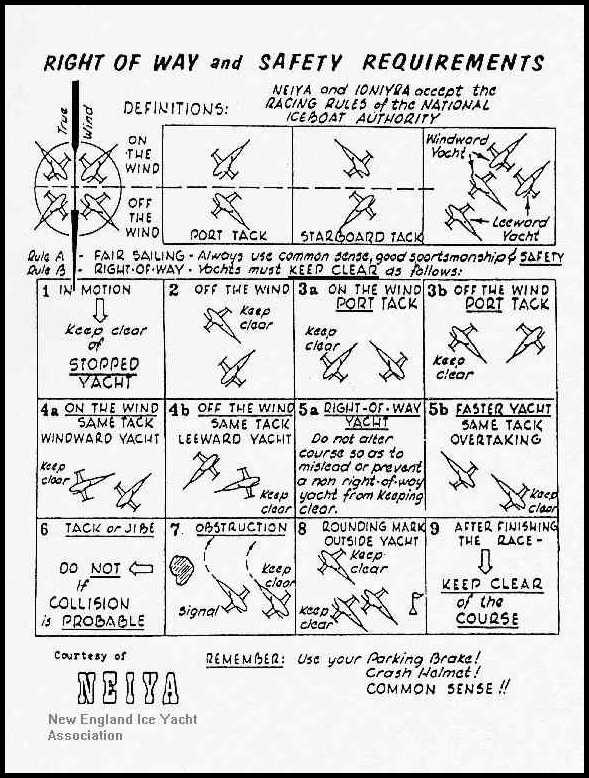
HRIYC.ORG Right of Way and Safety Guidelines |
2015 National Iceboat Authority Racing Rules Change Summary
Constitution and Racing Rules of the National Iceboat Authority
| Hal Chamberlain's graphic depicts the running conditions pilots will
encounter on the ice and how they should be handled by both skippers.
Before you take the helm to mix it up with the rest of the fleet, be sure you have a good mental map of how you are going to integrate these guidelines with current conditions such as:
New sailors may find these tips helpful for learning
the basic rules. |

National Iceboat Authority
Right-of-Way Rules Graphic
Three Discovery Channel Videos
Dr. Giesbrecht on Cold Water Survival
Properties of Ice
Bob Dill's Lake Ice
Explaining Ice: The Answers Are Slippery
How Strong is Ice?
Safety on Floating Ice Sheets -- US Army Corps of Engineers
Ice Engineering -- Safe Loads on Ice Sheets -- US Army Corps of Engineers
The above publications offer a simple formula to estimate the minimum ice thickness required to support a load as
where h is the ice thickness in inches and P is the load, or gross weight, in tons. As Bob Dill of Lake Ice rightly advises, this is the minimum value, and if you compute the value for an average 200 pound person, you will get a value that is dangerously close to the threshold of where you will most assuredly break through. A more conservative equation that is more in line with the Minnesota DNR advice would be to double the resulting thickness values derived from the above equation. The original chart was developed with shipping military cargo in mind where some risk was assumed. When exploring any natural sheet of ice less than 4 inches thick you need to have your wits about you at all times, exercise extreme caution until you have mapped the sheet, and be prepared for self rescue.
The equation, graph and table assume clear, sound hard black ice. If soft white snow ice, or hard ice filled with bubbles makes up part or all of the ice thickness, a much more conservative approach must be taken and the safe working values for thickness need to be doubled, tripled, or even quadrupled. Any recent large snowstorm creates a new load on the ice. If the new snow is heavy enough, the ice sheet will sag in places or the entire sheet may become submerged as it attains its new buoyancy level. Water will slowly flood the new snow on the ice from below as it bleeds through cracks and small holes in the ice, creating a slushy mess just below what may look like a pristine cover of snow. Until this slush is completely frozen, the ice is very soft, weak, and unstable -- the best advice it to stay off of it -- self rescue or assisted rescue is extremely difficult in these situations. When the saturated snow becomes completely frozen, it is an added thickness of white ice, which is not nearly as strong as the hard black ice that originally formed the surface ice layer.
|
Disclaimer HRIYC.ORG is neither the official website, nor am I the webmaster, of the Hudson River Ice Yacht Club. I am a long standing member of the Club -- during the sailing season, I frequently post photographs and information on this, my own personal website, about current ice boating activity in the Hudson Valley and beyond. I am the sole person responsible for the presentation of content and the opinions expressed herein. Interesting photographic contributions are welcome and appreciated -- I spend most of my time on the ice skippering and far too often fail to capture the best images the day has to offer. JAS |
ŠJohn A. Sperr MMXVI